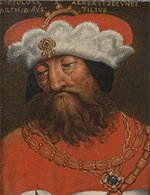Leopold III: Duke of Austria
Leopold III was Duke of Austria for two decades in the 14th Century, sharing power with his brother Albert. 
He was born on Nov. 1, 1351, in Vienna, the son of Albert II and Joanna of Pfirt. Leopold had an older brother, Frederick, who died in 1362. That left the governing of Austria in the hands of Leopold and his slightly older brother Albert, in support of their older brother, Rudolf. A few years before that, Rudolf had pulled a stunt in order to increase his reputation and prospects for power. Holy Roman Emperor Charles IV had named the seven who would have the power to select the King of the Romans (Germany). Rudolf, who since 1358 had been the head of the House of Habsburg, was incensed that he was not on that list and so ordered the "discovery" of the Privilegium maius, a trove of documents that elevated Austria to the status of an archduchy, with rights equal to the prince-electors named Charles IV's Golden Bull. The emperor recognized this claim for the falsity that it was and refused to recognize the Habsburg ruler's claims. A frustrated Rudolf died in 1365. Meanwhile, Albert and Leopold were widening their sphere of influence elsewhere, absorbing surrounding territory such as the County of Tyrol and the Swabian city of Freiburg. The brothers eventually disagreed on the way forward and, in the 1379 Treaty of Neuberg, divided the lands between them. Albert got Austria, and Leopold got Carinthia, Carniola, Styria, and the Tyrol. Leopold's expansion efforts rankled the leaders of the Old Swiss Confederacy, sparking a conflict that turned violent. At the Battle of Sempach, in 1386, Leopold died. A number of other Austrian nobles died as well. This left Albert as sole ruler of all Austrian lands. Leopold had married Viridis Visconti on Feb. 23, 1365. They had seven children, four of whom are known to have survived into adulthood: William, Leopold, Ernest, and Frederick. |
|
Social Studies for Kids
copyright 2002–2026
David White




